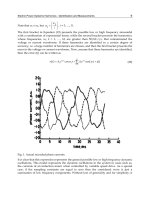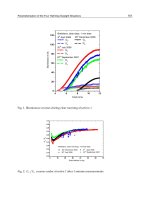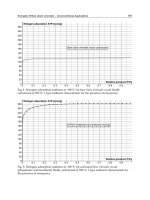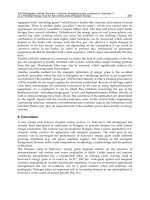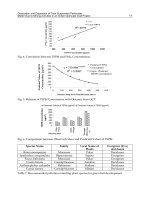Handbook Properties and Selection Nonferrous Alloys and Spl Purpose Mtls (1992) WW Part 2 docx
Bạn đang xem bản rút gọn của tài liệu. Xem và tải ngay bản đầy đủ của tài liệu tại đây (1.53 MB, 250 trang )
316 600 45 6.5 34 5 65
371 700 30 4.3 24 3.5 72
(a)
0.2% offset
Table 19 Tensile-property limits for alloy 2014
Tensile strength
Minimum
Maximum
Yield strength (min) Temper
MPa
ksi
MPa
ksi MPa ksi
Elongation
(a)
%
Flat products (bare)
Sheet and plate, O
0.020-0.499 in. thick
. . . . . .
220 32 110 (max)
16 (max)
16
0.500-1.000 in. thick
. . . . . .
220 32 . . . . . . 10
Flat sheet, T3
0.020-0.039 in. thick
405 59 . . . . . . 240 35 15
0.040-0.249 in. thick
405 59 . . . . . . 250 36 14
Coiled sheet, T4
0.020-0.0249 in. thick
405 59 . . . . . . 240 35 14
Plate, T45l
(b)
0.250-2.000 in. thick
400 58 . . . . . . 250 36 14-12
2.001-3.000 in. thick
395 57 . . . . . . 250 36 8
Sheet and plate, T42
0.020-1.000 in. thick
400 58 . . . . . . 235 34 14
Sheet, T6, T62
0.020-0.039 in. thick
440 64 . . . . . . 395 57 6
0.040-0.0249 in. thick
455 66 . . . . . . 400 58. . . 7
Plate, T62, T651
0.250-2.000 in. thick
460 67 . . . . . . 405 59 7-4
2.001-2.500 in. thick
450 65 . . . . . . 400 58 2
2.501-3.000 in. thick
435 63 . . . . . . 395 57 2
3.001-4.000 in. thick
405 59 . . . . . . 380 55 1
Flat products (Alclad)
Sheet and plate, O
0.020-0.499 in. thick
. . . . . .
205 30 95 (max) 14 (max)
16
0.500-1.000 in. thick
. . . . . .
220 32 . . . . . . 10
Flat sheet, T3
0.020-0.024 in. thick
370 54 . . . . . . 230 33 14
0.025-0.039 in thick
380 55 . . . . . . 235 34 14
0.040-0.249 in. thick
395 57 . . . . . . 240 35 15
Coiled sheet, T4
0.020-0.024 in. thick
370 54 . . . . . . 215 31 14
0.025-0.039 in. thick
380 55 . . . . . . 220 32 14
0.040-0.249 in. thick
395 57 . . . . . . 235 34 15
Plate, T451
(b)
0.500-2.000 in. thick
400 58 . . . . . . 250 36 12-14
0.250-0.499 in. thick
395 57 . . . . . . 250 36 15
0.500-2.000 in. thick
400 58 . . . . . . 250 36 12-14
2.001-3.000 in. thick
395 57 . . . . . . 200 36 8
Sheet and plate, T4
0.020-0.024 in. thick
370 54 . . . . . . 215 31 14
0.025-0.039 in. thick
380 55 . . . . . . 220 32 14
0.040-0.499 in. thick
395 57 . . . . . . 235 34 15
0.500-1.000 in. thick
400 58 . . . . . . 235 34 14
Sheet, T6
0.020-0.024 in. thick
425 62 . . . . . . 370 54 7
0.025-0.039 in. thick
435 63 . . . . . . 380 55 7
0.040-0.249 in. thick
440 64 . . . . . . 395 57 8
Plate, T62, T651
0.250-0.499 in. thick
440 64 . . . . . . 395 57 8
0.500-2.000 in. thick
460 67 . . . . . . 405 59 6
2.001-2.500 in. thick 450 65 . . . . . . 400 58 2
2.501-3.000 in. thick
435 63 . . . . . . 395 57 2
3.001-4.000 in. thick
405 59 . . . . . . 380 55 1
Rolled or cold finished wire (rod and bar)
T4, T42, T451
(b)
380 55 . . . . . . 220 32 16
T6, T62, T651 450 65 . . . . . . 380 55 8
Extruded wire, rod, bar, and shapes
O . . . . . .
205 30 125 (max)
12 (max)
12
T4, T4510, T4511 345 50 . . . . . . 240 35 12
T42 345 50 . . . . . . 200 29 12
T6, T6510, T6511
≤0.499 in. thick
415 60 . . . . . . 365 53 7
0.500-0.749 in. thick
440 64 . . . . . . 400 58 7
0.750 in. thick
470 68 . . . . . . 415 60 7
T62 415 60 . . . . . . 365 53 7
(c)
Extruded tube
O . . . . . .
205 30 125 (max)
18 (max)
12
T4, T4510, and T4511 345 50 . . . . . . 240 35 12
T42 345 50 . . . . . . 200 29 12
T6, T6510, T6511
≤0.499 in. thick
415 60 . . . . . . 365 53 7
0.500-0.749 in. thick
440 64 . . . . . . 400 58 7
≥0.750 in. thick
470 68 . . . . . . 415
(d)
60
(d)
7
(d)
T62 415 60 . . . . . . 365 53 7
(c)
Drawn tube
O, 0.18-0.500 in. thick . . . . . .
220 32. . .
110 (max)
16 (max)
. . .
T4, T42
0.018-0.500 in. thick
370 54 . . . . . . 205 30 10-16
Die forgings: axis parallel to direction of grain flow
T4, ≤4 in. thick
380 55 . . . . . . 205 30 11
(e)(f)
T6
≤2 in. thick
450 65 . . . . . . 385 56 6
(e)
,
(g)
>2-3 in. thick
450 65 . . . . . . 380 55 6
(e)
,
(g)
≤3-4 in. thick
435 63 . . . . . . 380 55 6
(e)
,
(g)
Die forgings: axis not parallel to direction of grain flow
T6
≤2 in. thick
440 64 . . . . . . 380 55 3
(e)
,
(h)
>2-4 in. thick
435 63 . . . . . . 370 54 2
(e)
Hand forgings
T6
≤2.000 in. thick longitudinal, long transverse
450 65 . . . . . . 385 56 3-8
2.001-3.000 in. thick
longitudinal
440 64 . . . . . . 385 56 8
Long transverse
440 64 . . . . . . 380 55 3
Short transverse
425 62 . . . . . . 380 55 2
3.001-4.000 in. thick
Longitudinal, long transverse
435 63 . . . . . . 380 55 3-8
Short transverse
420 61 . . . . . . 370 54 2
4.001-5.000 in. thick
Longitudinal, long transverse
425 62 . . . . . . 370 54 2-7
Short transverse
415 60 . . . . . . 365 53 1
5.001-6.000 in. thick
Longitudinal, long transverse
420 61 . . . . . . 365 53 2-7
Short transverse
405 59 . . . . . . 365 53 1
6.001-7.000 in. thick
Longitudinal
Long transverse
415 60 . . . . . . 360 52 2-7
Short transverse
400 58 . . . . . . 360 52 1
7.001-8.000 in. thick
Longitudinal, long transverse
405 59 . . . . . . 350 51 2-7
Short transverse
395 57 . . . . . . 350 51 1
T652
2.000 in. thick Longitudinal, long transverse
450 65 . . . . . . 385 56 3-8
2.001-3.000 in. thick
Longitudinal
440 64 . . . . . . 385 56 8
Long transverse
440 64 . . . . . . 380 55 3
Short transverse
425 62 . . . . . . 360 52 2
3.001-4.000 in. thick
Longitudinal, long transverse
435 63 . . . . . . 380 55 3-8
Short transverse
420 61 . . . . . . 350 51 2
4.001-5.000 in. thick
Longitudinal, long transverse
425 62 . . . . . . 370 54 2-7
Short transverse
415 60 . . . . . . 345 50 1
5.001-6.000 in. thick
Longitudinal, long transverse
420 61 . . . . . . 365 53 2-7
Short transverse
405 59 . . . . . . 345 50 1
6.001-7.000 in. thick
Longitudinal, long transverse
415 60 . . . . . . 360 52 2-6
Short transverse
400 58 . . . . . . 340 49 1
7.001-8.000 in. thick
Longitudinal, long transverse
405 59 . . . . . . 350 51 2-6
Short transverse
395 57 . . . . . . 330 48 1
Rolled rings, T6, T652
2.500 in. thick
Tangential
450 65 . . . . . . 380 55 7
Axial
425 62 . . . . . . 380 55 3
Radial
415 60 . . . . . . 360 52 2
2.501-3.000 in. thick
Tangential
450 65 . . . . . . 380 55 6
Axial
425 62 . . . . . . 360 52 2
(a)
In 50 mm (2 in.) or 4d, where d is diameter
of reduced section of tensile test specimen. Where a range of values appears in this column,
specified minimum elongation varies with thickness of the mill product.
(b)
Upon artificial aging, T451 temper material develops properties applicable to T651 temper.
(c)
6% elongation for products over 19 mm (0.750 in.) in diameter or thickness and over 160 through 205 cm
2
(25 through 32 in.
2
) in cross-
sectional area.
(d)
Value slightly lower for material over 160 through 205 cm
2
(25 through 32 in.
2
) in cross-sectional area.
(e)
Test bar machined from sample forging.
(f)
16% for test bar taken from separately forged coupon.
(g)
8% for test bar taken from separately forged coupon.
(h)
2% for forgings over 25 through 50 mm (1 through 2 in.) thick
Compressive yield strength. Approximately the same as tensile yield strength
Hardness. O temper: 87 to 98 HRH; 45 HB. T4 temper: 65 to 73 HRB; 105 HB. T6 temper: 80 to 86 HRB; 135 HB. HB
values obtained using 500 kg load and 10 mm diam ball
Poisson's ratio. 0.33 at 20 °C (68 °F)
Elastic modulus. Tension: 2014, 72.4 GPa (10.5 × 10
6
psi); Alclad 2014, 71.7 GPa (10.4 × 10
6
psi). Shear: 2014 and
Alclad 2014, 28 GPa (4.0 × 10
6
psi). Compression: 2014, 73.8 GPa (10.7 × 10
6
psi); Alclad 2014, 73.1 GPa (10.6 × 10
6
psi)
Fatigue strength. O temper, 90 MPa (13 ksi); T4 temper, 140 MPa (20 ksi); T6 temper, 125 MPa (18 ksi); all at 5 ×
10
8
cycles in an R.R. Moore type test
Mass Characteristics
Density. 2.80 g/cm
3
(0.101 lb/in.
3
) at 20 °C (68 °F)
Thermal Properties
Liquidus temperature. 638 °C (1180 °F)
Solidus temperature. 507 °C (945 °F)
Coefficient of thermal expansion. Linear:
Temperature range Average coefficient
°C °F μm · K
μin./in. · °F
-50 to 20
-58 to 68
20.8 11.5
20 to 100
68 to 212
22.5 12.5
20 to 200
68 to 392
23.4 13.0
20 to 300
68 to 572
24.4 13.6
Volumetric: 65.1 × 10
-6
m
3
/m
3
· K (3.62 × 10
-5
in.
3
/in.
3
· °F)
Thermal conductivity. At 20 °C (68 °F); O temper, 192 W/m · K (111 Btu/ft · h · °F); T3, T4, T451 tempers, 134 W/m
· K (77.4 Btu/ft · h · °F); T6, T651, T652 tempers, 155 W/m · K (89.5 Btu/ft · h · °F)
Electrical Properties
Electrical conductivity. At 20 °C (68 °F): O temper, 50% IACS, T3, T4, T451 tempers, 34% IACS; T6, T651, T652
tempers, 40% IACS
Electrical resistivity. At 20 °C (68 °F): O temper, 34 nΩ · m; T3, T4, T451 tempers, 51 nΩ · m; T6, T651, T652
tempers, 43 nΩ · m. Temperature coefficient: O, T3, T4, T451, T6, T651, T652 tempers, 0.1 nΩ · m per K at 20 °C (68
°F).
Electrolytic solution potential. At 25 °C (77 °F): -0.68 V (T3, T4, T451 tempers) or -0.78 V (T6, T651, T652
tempers) versus 0.1 N calomel electrode in an aqueous solution containing 53 g NaCl plus 3 g H
2
O
2
per liter
Fabrication Characteristics
Annealing temperature. 413 °C (775 °F)
Solution temperature. 502 °C (935 °F)
Aging temperature. T6 temper. Sheet, plate, wire, rod, bar, shapes, and tube: 160 °C (320 °F) for 18 h at temperature.
Forgings: 171 °C (340 °F) for 10 h at temperature
2017
4.0Cu-0.6Mg-0.7Mn-0.5Si
Specifications
ASTM. B 211 and B 316
SAE. J454
ANSI. H38.4 and H38.12
UNS number. A92017
Government. QQ-A-222/5, QQ-A-430, MIL-R-430
Foreign. France: A-U46. Germany: AlCuMg1 and 3.1325. Great Britain: L18 and 150A. Canada: CM41. Austria:
AlCuMg1. ISO: AlCuMgSi
Chemical Composition
Composition limits. 0.20 to 0.80 Si, 0.7 max Fe, 3.5 to 4.5 Cu, 0.4 to 0.80 Mg, 0.40 to 1.0 Mn, 0.10 max Cr, 0.15 max
Ti, 0.25 max Zn, 0.05 other (each), 0.15 others (total); bal Al
Applications
Typical uses. Alloy 2017, which was the first alloy developed in the Al-Cu-Mg series, is now in rather limited use,
chiefly for rivets. Used in components for general engineering purposes, structural applications in construction and
transportation, screw machine products, and fittings.
General characteristics. Age-hardenable wrought aluminum alloy with medium strength and ductility, good
machinability, good formability, and fair resistance to atmospheric corrosion. Welding is not recommended unless heat
treatment after welding is practicable. Its service temperature is below 100 °C (212 °F).
Forms available. Forgings, extrusions, bars, rods, wire, shapes, and rivets
Mechanical Properties
Tensile properties. See Tables 20 and 21.
Table 20 Typical room-temperature mechanical properties of 2017
Temper condition Property
O T4, T451
Tensile strength, MPa (ksi) 180 (26)
427 (62)
Yield strength (0.2% offset), MPa (ksi) 70 (10) 275 (40)
Elongation in 50 mm (2 in.)
(a)
, % 22 22
Hardness, HB
(b)
45 105
Shear strength, MPa (ksi) 125 (18)
262 (38)
(a)
Specimens 13 mm (
1
2
in.) diameter.
(b)
500 kg load, 10 mm ball
Table 21 Typical tensile properties of 2017 (T4 and T451 tempers) at various temperatures
Test temperature
(a)
Tensile strength
Yield strength
(0.2% offset)
°C °F MPa ksi MPa ksi
Elongation in
50 mm
(2 in.), %
-196 -320 550 80 365 53 28
-80 -112 448 65 290 42 24
-28 -18 440 64 283 41 23
24 75 427 62 275 40 22
100 212 393 57 270 39 18
149 300 275 40 207 30 15
204 400 110 16 90 13 35
260 500 62 9 52 7.6 45
316 600 40 6 35 5 65
371 700 30 4.3 24 3.5 70
(a)
Tested after holding 10,000 h at temperature
Hardness. See Table 20.
Shear strength. See Table 20.
Modulus of elasticity. 72.4 GPa (10.5 × 10
6
psi) average of tension and compression; modulus is about 2% greater for
compression than tension
Modulus of rigidity. 27.5 GPa (4 × 10
6
psi)
Fatigue strength. See Table 20.
Mass Characteristics
Density. 2.80 g/cm
3
(0.101 lb/in.
3
)
Thermal Properties
Liquidus temperature. 640 °C (1185 °F)
Solidus temperature. 513 °C (955 °F)
Thermal conductivity. At 25 °C (77 °F): 193 W/m · °C (1340 Btu · in./ft
2
· h · °F) with an O temper and 134 W/m · °C
(930 Btu · in./ft
2
· h · °F) with a T4 temper
Coefficient of thermal expansion. From 20 to 100 °C (68 to 212 °F): 23.6 μm/m · °C (13.1 μin./in. · °F)
Electrical Properties
Electrical conductivity. At 20 °C (68 °F): 50% IACS on a volume basis (159% IACS) on weight basis) with an O
temper; 34% IACS on a volume basis (108% IACS on a weight basis) with a T4 temper
Electrical resistivity. At 20 °C (68 °F): 0.035 Ω· mm
2
/m (21 Ω· circ mil/ft)with an O temper and 0.05 Ω· mm
2
/m (30
Ω· circ mil/ft) with a T4 temper
Fabrication Characteristics
Annealing temperature. 415 °C (775 °F) for a heat-treated anneal and 340 to 350 °C (640 to 660 °F) for cold-work
anneal
Solution temperature. 500 to 510 °C (930 to 950 °F)
Aging temperature. Room temperature
Machinability. Fair to good in the annealed condition and excellent in the solution treated and naturally aged condition
(T4 temper)
Workability. Has good formability. In the annealed condition (O temper) its formability is equal to or superior to 2024-
O. In the T4 temper condition, it forms as readily as 2024-T3 or 2024-T4.
Weldability. Because of the effect of heating on corrosion resistance, welding is rarely recommended except where heat
treatment after welding is practicable. The inert gas method and resistance welding have given satisfactory results. Gas
welding, brazing, and soldering are not successful. This alloy is so sensitive to cracking during welding that other
aluminum alloys, joint design, fixtures, and so on must be arranged so as to put a minimum stress on the joint during
cooling. The best filler material is parent metal.
Corrosion Resistance
2017 has a fair resistance to atmospheric corrosion, depending on its thermal treatment. Quenching slowly from the
solution-treatment temperature lowers the resistance to corrosion and makes this alloy susceptible to intergranular attack.
The same result is obtained by heating the alloy after solution treatment. If, however, the alloy has been slowly quenched,
artificial aging tends to restore the normal resistance to attack; in fact, for material that is to be artificially aged, a mild
quench may be preferable. For thicker sections, the rate of cooling even by immersion in cold water is not great enough to
produce complete freedom from susceptibility to intergranular attack. In thin sections the solution treated material, being
aged at room temperature, is more resistant to corrosion than the fully aged material, while in heavy sections the latter is
more resistant because of the beneficial effect of artificial aging on more slowly cooled material.
2024, Alclad 2024
4.4Cu-1.5Mg-0.6Mn
Specifications
AMS. See Table 22.
Table 22 Standard specifications for alloy 2024
Specification number Mill form and
condition
AMS
ASTM
Government
Bare 2024
4033 B 209 QQ-A-250/4
4035 . . . . . .
4037 . . . . . .
4097 . . . . . .
4098 . . . . . .
4099 . . . . . .
4103 . . . . . .
4104 . . . . . .
4105 . . . . . .
4106 . . . . . .
4192 . . . . . .
Sheet and plate
4193 . . . . . .
4112 B 211 QQ-A-225/6
4119 . . . . . .
Wire, rod, and bar (rolled or cold finished)
4120 . . . . . .
4152 B 221 QQ-A-200/3
4164 . . . . . .
Wire, rod, bar, shapes, and tube (extruded)
4165 . . . . . .
Tube (extruded, seamless) . . . B 241 . . .
4087 B 210 WW-T-700/3 Tube (drawn, seamless)
4088 . . . MIL-T-50777
Tube (hydraulic) 4086 . . . . . .
Rivet wire and rod . . . B 316 QQ-A-430
Foil 4007 . . . MIL-A-81596
Alclad 2024
4034 B 209 QQ-A-250/5
4040 . . . . . .
4041 . . . . . .
4042 . . . . . .
4060 . . . . . .
4061 . . . . . .
4072 . . . . . .
4073 . . . . . .
4074 . . . . . .
4075 . . . . . .
4194 . . . . . .
Sheet and plate
4195 . . . . . .
ASME. Rolled or drawn wire, rod, and bar: SB211. Extrusions: SB221
ASTM. See Table 22.
SAE. J454
UNS number. A92024
Government. See Table 22.
Foreign. Austria: Önorm AlCuMg2. Canada: CSA CG42. France: NF A-U4G1. Italy: UNI P-AlCu4.5MgMn; Alclad
2024, P-AlCu4.5MgMn placc. Spain: UNE L-314. Germany: DIN AlCuMg2
Chemical Composition
Composition limits. 0.5 Si max, 0.50 Fe max, 3.8 to 4.9 Cu, 0.30 to 0.9 Mn, 1.2 to 1.8 Mg, 0.10 Cr max, 0.25 Zn max,
0.15 Ti max, 0.05 max other (each), 0.15 max others (total), bal Al
Composition limits of Alclad 2024. 1230 cladding 99.30 Al min, 0.7 Si max + Fe, 0.10 Cu max, 0.05 Mn max,
0.05 Mg max, 0.10 Zn max, 0.05 V max, 0.013 Ti max, 0.03 max other (each)
Applications
Typical uses. Aircraft structures, rivets, hardware, truck wheels, screw machine products, and other miscellaneous
structural applications
Mechanical Properties
Tensile properties. See Tables 23, 24, and 25.
Table 23 Typical tensile properties of alloy 2024
Temperature
Tensile strength
Yield strength
(0.2% offset)
Temper
°C °F MPa ksi MPa ksi
Elongation,
%
-196 -320 586 85 427 62 18
-80 -112 503 73 359 52 17
-28 -18 496 72 352 51 17
24 75 483 70 345 50 17
100 212 455 66 331 48 16
149 300 379 55 310 45 11
204 400 186 27 138 20 23
260 500 76 11 62 9 55
316 600 52 7.5 41 6 75
T3 (sheet)
371 700 34 5 28 4 100
-80 -112 490 71 338 49 19
-28 -18 476 69 324 47 19
24 75 469 68 324 47 19
100 212 434 63 310 45 19
149 300 310 45 248 36 17
204 400 179 26 131 19 27
260 500 76 11 62 9 55
316 600 52 7.5 41 6 75
371 700 34 5 28 4 100
-196 -320 579 84 469 68 11
-80 -112 496 72 407 59 10
-28 -18 483 70 400 58 10
24 75 476 69 393 57 10
100 212 448 65 372 54 10
149 300 310 45 248 36 17
204 400 179 26 131 19 27
260 500 76 11 62 9 55
316 600 52 7.5 41 6 75
T6, T651
371 700 34 5 28 4 100
-196 -320 586 85 538 78 8 T81, T851
-80 -112 510 74 476 69 7
-28 -18 503 73 469 68 7
24 75 483 70 448 65 7
100 212 455 66 427 62 8
149 300 379 55 338 49 11
204 400 186 27 138 20 23
260 500 76 11 62 9 55
316 600 52 7.5 41 6 75
371 700 34 5 28 4 100
-196 -320 634 92 586 85 5
-80 -112 558 81 531 77 5
-28 -18 538 78 510 74 5
24 75 517 75 490 71 5
100 212 483 70 462 67 6
149 300 372 54 331 48 11
204 400 145 21 117 17 28
260 500 76 11 62 9 55
316 600 52 7.5 41 6 75
T861
371 700 34 5 28 4 100
Table 24 Typical mechanical properties of alloy 2024
Tensile
strength
Yield
strength
Shear
strength
Fatigue
strength
(c)
Temper
MPa
ksi
MPa
ksi
Elongation
(a)
,
%
Hardness
(b)
,
HB
MPa
ksi
MPa
ksi
Bare 2024
O 185 27 75 11 20 47 125 18 90 13
T3 485 70 345 50 18 120 285 41 140 20
T4, T351 470 68 325 47 20 120 285 41 140 20
T361 495 72 395 57 13 130 290 42 125 18
Alclad 2024
O 180 26 75 11 20 . . . 125 18 . . . . . .
T3 450 65 310 45 18 . . . 275 40 . . . . . .
T4, T351 440 64 290 42 19 . . . 275 40 . . . . . .
T361 460 67 365 53 11 . . . 285 41 . . . . . .
T81, T851
450 65 415 60 6 . . . 275 40 . . . . . .
T861 485 70 455 66 6 . . . 290 42 . . . . . .
(a)
1.6 mm (
1
16
in.) thick specimen.
(b)
500 kg load; 10 mm ball.
(c)
At 5 × 10
8
cycles of completely reversed stress; R.R. Moore type test
Table 25 Tensile property limits for alloy 2024
Tensile strength (min)
Yield strength (min) Temper
MPa ksi MPa ksi
Elongation
(min)
(a)
, %
Sheet and plate
O 220 (max) 32 (max) 95 (max) 14 (max)
12
T42
0.010-0.499 in. thick
425 62 260 38 12-15
0.500-1.000 in. thick
420 61 260 38 8
1.001-2.000 in. thick
415 60 260 38 6-7
2.001-3.000 in. thick
400 58 260 38 4
T62
0.010-0.499 in. thick
440 64 345 50 5
0.500-3.000 in. thick
435 63 345 50 5
T361
0.020-0.062 in. thick
460 67 345 50 8
0.063-0.249 in. thick
470 68 350 51 9
0.250-0.500 in. thick
455 66 340 49 9-10
T861
0.020-0.062 in. thick
485 70 425 62 3
0.063-0.249 in. thick
490 71 455 66 4
0.250-0.499 in. thick
485 70 440 64 4
Alclad O
0.008-0.062 in. thick
205 (max) 30 (max) 95 (max) 14 (max)
10-12
0.063-1.750 in. thick
(b)
220 (max) 32 (max) 95 (max) 14 (max)
12
Alclad T42
0.008-0.009 in. thick
380 55 235 34 10
0.010-0.062 in. thick
395 57 235 34 12-15
0.063-0.499 in. thick
415 60 250 36 12-15
0.500-1.000 in. thick
(b)
420 61 260 38 8
1.001-2.000 in. thick
(b)
415 60 260 38 6-7
2.001-3.000 in. thick
(b)
400 58 260 38 4
Alclad T62
0.010-0.062 in. thick
415 60 325 47 5
0.063-0.499 in. thick
425 62 340 49 5
Alclad T361
0.020-0.062 in. thick
420 61 325 47 8
0.063-0.499 in. thick
440 64 330 48 9
0.500 in. thick
(b)
445 66 340 49 10
Alclad T861
0.020-0.062 in. thick
440 64 400 58 3
0.063-0.249 in. thick
475 69 440 64 4
0.250-0.499 in. thick
470 68 425 62 4
0.500 in. thick
(b)
485 70 440 64 4
Flat Sheet
T3
0.008-0.128 in. thick
435 63 290 42 10-15
0.129-0.249 in. thick
440 64 290 42 15
T81 460 67 400 58 5
Alclad T3
0.008-0.009 in. thick
400 58 270 39 10
0.010-0.062 in. thick
405 59 270 39 12-15
0.063-0.128 in. thick
420 61 275 40 15
0.129-0.249 in. thick
425 62 275 40 15
Alclad T81
0.010-0.062 in. thick
425 62 370 54 5
0.063-0.249 in. thick
450 65 385 56 5
Sheet
T72 415 60 315 46 5
Alclad T72
0.010-0.062 in. thick
385 56 295 43 5
0.063-0.249 in. thick
400 58 310 45 5
Coiled sheet
T4 425 62 275 40 12-15
Alclad T4
0.010-0.060 in. thick
400 58 250 36 12-15
0.063-0.128 in. thick
420 61 260 38 15
Plate
T351
0.250-0.499 in. thick
440 64 290 42 12
0.500-1.000 in. thick
435 63 290 42 8
1.001-2.000 in. thick
425 62 290 42 6-7
2.001-3.000 in. thick
415 60 290 42 4
3.001-4.000 in. thick
395 57 285 41 4
T851
0.250-0.499 in. thick
460 67 400 58 5
0.500-1.000 in. thick
455 66 400 58 5
1.001-1.499 in. thick
455 66 395 57 5
Alclad T351
0.250-0.499 in. thick
425 62 275 40 12
0.500-1.000 in. thick
(b)
435 63 290 42 8
1.001-2.000 in. thick
(b)
425 62 290 42 6-7
2.001-3.000 in. thick
(b)
415 60 290 42 4
3.001-4.000 in. thick
(b)
395 57 285 41 4
Alclad T851
0.250-0.499 in. thick
450 65 385 56 5
0.500-1.000 in. thick
(b)
455 66 400 58 5
Wire, rod, and bar (rolled or cold finished)
O 24 (max) 35 (max) . . . . . . 16
T36 475 69 360 52 10
T4
0.499 in. thick or in diam
425 62 310
(c)
45
(c)
10
0.500-4.500 in. thick or in diam
425 62 290
(c)
42
(c)
10
4.501-6.500 in. thick or in diam
425 62 275
(c)
40
(c)
10
6.501-8.00 in. in diam
400 58 260 38 10
T42 425 62 275 40 10
T351 425 62 310 45 10
T6 425 62 345 50 5
T62 415 60 315 46 5
T851 455 66 400 58 5
Wire, rod, bar and shapes (extruded)
O 240 (max) 35 (max) 130 (max)
19 (max)
12
T3, T3510, T3511:
≤0.249 in. thick or in diam
395 57 290 42 12
0.250-0.749 in. thick or in diam
415 60 305 44 12
0.750-1.499 in. thick or in diam
450 65 315 46 10
≥1.5000 in. thick or in diam:
≤25 in.
2
area
485 70 360 52 10
>25-32 in.
2
area
470 68 330 48 8
T42 395 57 260 38 8-12
T81, T851, T8510, T8511
0.050-0.249 in. thick or in diam
440 64 385 56 4
0.250-≥1.500 in. thick or in diam: area ≤32 in.
2
455 66 400 58 5
Extruded tube
O 240 (max) 35 (max) 130 (max)
19 (max)
12
T3, T3510, T3511
≤0.249 in. thick
395 57 290 42 10
0.250-0.749 in. thick;
415 60 305 44 10
0.750-1.499 in. thick
450 65 315 46 10
≥1.500 and over in. thick
Area ≥25 in.
2
485 70 330 48 10
Area >25-32 in.
2
470 68 315 46 8
T42 395 57 260 38 8-12
T81, T8510, T8511
0.050-0.249 in. thick
440 64 385 56 4
0.250-≥1.500; area ≤32 in.
2
455 66 400 58 5
Drawn Tube
O 220 (max) 32 (max) 105 (max)
15 (max)
. . .
T3 440 64 290 42 10-16
(e)
T42 440 64 275 40 10-16
(e)
Rivet and cold-heading wire and rod
O 240 (max) 35 (max) . . . . . . . . .
220 32 . . . . . . . . . H13
290 (max) 42 (max) . . . . . . . . .
T4 425 62 275 40 10
(a)
In 50 mm (2 in.) or 4d, where d is diameter of reduced section of tension-test specimen. Where a range of values appears in this column, the
specified minimum elongation varies with thickness of the mill product.
(b)
For plate 12.7 mm (0.500 in.) or over in thickness, listed properties apply to core material only. Tensile and yield strengths of composite plate
are slightly lower than the listed value, depending on thickness of the cladding.
(c)
Minimum yield strength of coiled wire and rod, 276 MPa (40 ksi).
(d)
Applicable to rod only.
(e)
Full section specimen; minimum elongation is 10 to 12% for cut-out specimen
Shear strength. See Table 24.
Hardness. See Table 24.
Poisson's ratio. 0.33 at 20 °C (68 °F)
Elastic modulus. Tension, 72.4 GPa (10.5 × 10
6
psi); shear , 28.0 GPa (4.0 × 10
6
psi); compression, 73.8 GPa (10.7 ×
10
6
psi)
Fatigue strength. See Table 24.
Elevated-temperature strengths. See Fig. 4.
